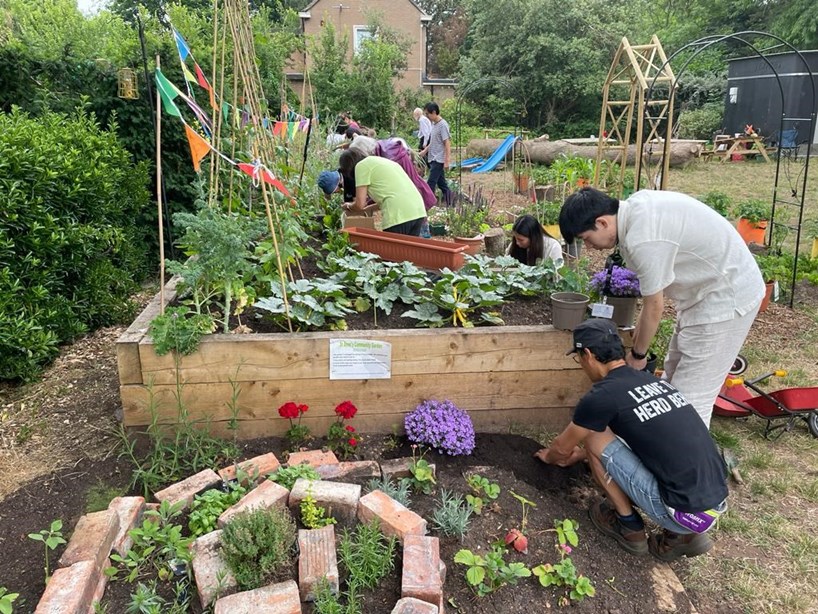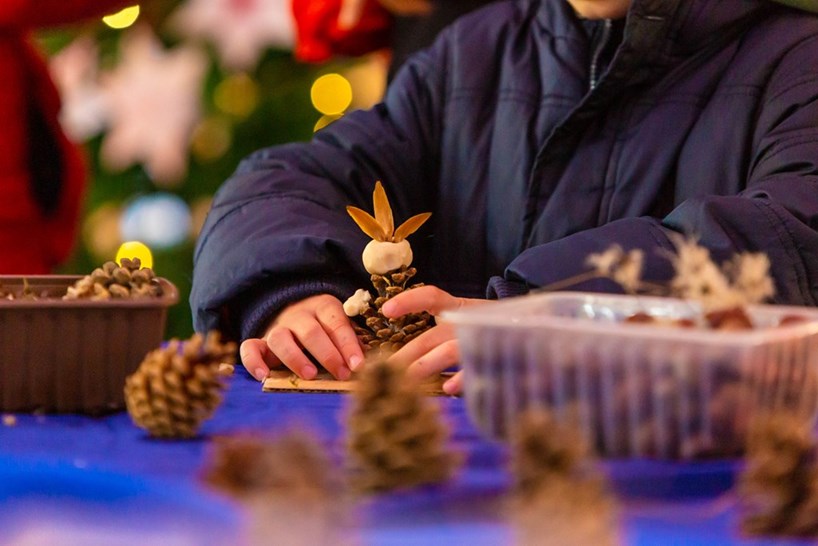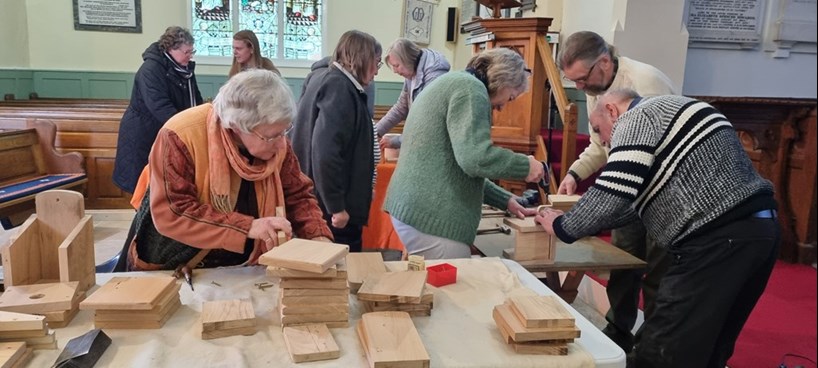Environment: How churches have gone green
International
More churches are worshipping God in eco-conscious ways. Huw Spanner examines three of them

It is one of August’s rainy days when I visit Hazelnut Community Farm, in east Bristol. It is not a farm as such, but “a growing community of friends, organisations, and partners based around community gardening, climate action, and faith”, its Facebook page says.
Today, because of the weather, just seven people and a dog have gathered with Hazelnut’s leader, the Revd John White, for a brief liturgy and a reading in St Anne’s church hall, followed by some work on the vegetable beds outside. Usually, on one of their Thursday “Grow Together” days, they might expect 15 to turn up, Mr White says. Nevertheless, on the afternoon I visit, the sense of community is undeniable.
The plot of land itself, which Hazelnut has had the use of only since March, is less than one quarter of an acre, and most of it is rather untidy grass. The many vegetable beds they have created in just six months, however, are neat, compact, and bursting with biodiversity. Currently, they have more than 20 crops, from aubergines to wheat. The community has also planted bee-friendly flowers, including verbena, jasmine, and some spectacular “Russian Giant” sunflowers.
Mr White moved to this country from his native United States 14 years ago, in part because he had developed a fascination with Anglican tradition and culture. While training at Trinity College, Bristol, he became a pioneer minister (though he does not use the term now).
In 2019, he was visiting a city farm with his two children when he experienced what Pope Francis in Laudato Si’ calls an “ecological conversion”. “I had known that the climate emergency was an important issue, but I didn’t know what to do about it,” he says. All of a sudden, he saw that “nature, the climate, is the single most important issue that is going to put pressure on all other issues, and it needs creative thinking.”

Hazelnut Community Farm, in east Bristol
I put it to him that terms such as “emergency” and “crisis” are misleading if they suggest that this is a moment of danger that will pass. Are we not, rather, entering a “new normal”?
“Absolutely,” he says. “A hundred per cent. Even [other eco churches] are focused so much on prevention, but so little on preparation, when the scientists are saying there is a huge change coming. ‘Net zero’ and all that is very good work, but what about the invention we’re going to need, of a different way of living and thinking?”
Advertisement
Is this “eco church” still seeking to create disciples of Jesus, or is it concerned entirely with “going green”? “We’re trying to encourage people to see the whole thing as discipleship,” he says. “We started with this emergency, but what has unfolded is a beautiful rediscovering of scripture, and even of liturgy — and of our history as well.
“We’re not actually doing anything the Church hasn’t done already. Not only the monastic tradition, but, even in Anglican history, new vicars used to be given an acre of land to care for. But we’ve lost touch with the land, even in our liturgy. We’ve slipped into a kind of gnosticism where we look for spiritual encounters to lift us out of the everyday, and we miss the fact that this is the context God has given us, and earth is our place of worship.”
Inspired by thinkers such as Norman Wirzba and Wendell Berry, Mr White contends that growing vegetables together is “the best prophetic act” for the Church right now. “You can plant a tree and then walk away; but growing vegetables, you have to respect and listen to the earth, because, if you don’t plant them right, and water them right. . . And you also create food which you can give away.”
Advertisement
Hazelnut is both a church-plant and a network, he says. On the one hand, it is now “a rooted community of about 40 people”. They follow the seasons, being busiest at seed time and harvest, and quietest in the winter. Over the summer, they come together for two hours on Thursday and Sunday afternoons to water and weed.
“Rather than singing songs,” Mr White enthuses, “we engage with creator and creation together, and that is our act of worship. The things we grow are almost like living ikons. They’re our prayers worked out.”
More than half of this community are newly resettled migrants from Hong Kong: some Christian, some not. The rest are “either not Christians at all, or go to other churches as well”. They also have some ordinands on placement.
“I never planned to reach all these folks from Hong Kong,” Mr White observes, “but there’s a cultural meeting-point in the common grace of land, and that’s really beautiful. You don’t always get that inside a building.”
Hong Kong is so overdeveloped, he says, that “even to get your hands in the soil is a rarity there. When they come over here, often they have houses with gardens, but don’t know what to do with them. They see what we’re doing here as really special.”

Shoppers at one of St Mary’s Eco Church pop-ups make creatures to help to complete a Christmas scene, alongside Nine Elms Arts Ministry, last December
How do the church’s non-Christian members see things? “We’ll say: ‘We’re a Christian community that welcomes those that are not Christian. We’re going to have a time now when we listen to creation and speak directly to God. If you want to, you can do that with us, or you can see this as a moment of peace.’”
Does God bless them with birdsong, I ask, in those moments? “Whenever we say, ‘Let’s be still and listen to the Lord,’ always a car alarm goes off, or there’s some loud noise. It’s hilarious. But we’re trying to encourage people to listen, not just to the wind in the trees but also to the traffic, to the couple down the road who are having a row. It’s all part of our context.”
As a network, Mr White says, “it’s all about inviting people in to share wisdom and learning together.” The plot in Bristol is “like a furnace from which the ideas are coming. We can try things out here, see what works; but a lot of what we do is engaging with other churches: rural and urban, High Church and Low Church, liberal and conservative.” He is much in demand as a speaker and preacher.
In its first two years, the community organised two international conferences on Zoom. The network now extends to Central Africa, where Hazelnut has a prayer partnership with the Noah Ark Creation Rescue Mission, which (its website says) “exists to help plant, encourage, and resource garden churches across the Democratic Republic of the Congo”.
“Because I came so late to this,” Mr White muses, “when I had that ‘conversion’, my first feeling was guilt. How come I haven’t thought about this before? How come I’m not already making my own granola — or my own clothes? I felt like a total failure. I recognise that there are loads of people who are just like that. The great majority care about the climate emergency, but just don’t know how to take a first step.
“So, we’ve written prayers that anyone can do in a church garden, free to download. We have a six-week Zoom course we call ‘Potting Shed’, and have just released the Growing Course, another six-week course that churches and small groups can use to reconnect with creator, creation, and community.”
Does he envisage that one day all churches will be like his? “We don’t claim to have all the answers,” he says, “but even if not everyone [follows our example], there are pieces of this that every church should be doing, or thinking about. There are lots of different ways this can be wrapped into the Church.”
Church in nature
St Mary’s Eco Church was created in 2021 by Southwark diocese, Lambeth Palace, and the parish of North Lambeth, in which it is based.
The vision, the Pioneer Team Vicar of St Mary’s, the Revd Dr Sharon Moughtin, explains, “is to sow a wildflower meadow of distinct little groups whose roots are entwined beneath the surface”.

Pond dipping at St Helen’s, St Helens, on the Isle of Wight
Currently, St Mary’s does not have a building: the church is the people, she says. “We pop up in different places: frequently in Archbishop’s Park, but also under the London Eye, in Battersea Power Station, by Tower Bridge.”
There is a Seedlings group, “where we meet with under-fives and their parents and carers every week in the park, and we notice the world around us and sing songs about it”. There is a teenage group, which chooses an environmental theme to consider each week, “whether it’s fast fashion, fair trade, or plastic waste”.
An adult group, the Eco Chamber (“an antidote to echo chambers”), meets for talks and discussions, in a pub or in Lambeth Palace Library. On Sundays, St Mary’s can be found in Archbishop’s Park, calling attention to a different part of its ecosystem (“it could be squirrels, or worms”).
In Genesis 2, Dr Moughtin says, when God placed the first human in a garden, the Hebrew words that traditionally have been translated “to till it and keep it” actually mean “to serve it and safeguard it”.
She continues: “Our role at St Mary’s is to create spaces where we learn to be part of the metaphorical gardens in which we’ve been placed, to serve and safeguard the land, and to become aware of the other creatures with which we share it, which matter to God as much as we do.”
What St Mary’s is doing, she believes, is pollinating ideas. “The aim is not to create something that can be reproduced exactly elsewhere. In other places, these seeds will grow differently, because the soil is different there, and so is the climate. And that’s just how it should be.”
Creation as mission
ST HELEN’S, St Helens, on the Isle of Wight, won an Eco Church Gold award from A Rocha UK in 2019: one of only 40 such churches in the country.
Dr Helen Bradstock, one of the churchwardens, explains that the driving force behind this had been their then Vicar, the Revd Alison Morley, “a powerhouse with a passion for sustainable living”. She moved on last year, but lay people are now carrying the torch onward with the full support of the PCC.
“We have a good-sized churchyard, and have set aside about half of it to encourage wildlife,” Dr Bradstock says. “Some areas we mow only two or three times a year, to allow wildflowers to bloom and attract butterflies and bees.
“In 2021, we created a pond, which now has dragonflies and newts.” Recently, a survey of the churchyard found 141 different wildlife species in one afternoon.
Once a month, on a Sunday afternoon, a dozen or so people meet as Eco Church. Some are regular congregants, but not all. They start with worship, which is “rooted in scripture, with an emphasis on seeing God in all things”, and then might make bird boxes and bat boxes, or do maintenance work on the pond. They are also active in the community, working with the village school to plant native trees, and with the parish council to manage the village green for biodiversity. “We see all of this as mission,” Dr Bradstock says.

Members of the Eco Church at St Helen’s, St Helens, Isle of Wight, make bird boxes from old pews
“I think there are ways that every parish can engage in these kinds of things,” she continues, “and it’s really important we do. We hear so much bad news about the climate, and we feel powerless. But if you take small measures in your own community, it can mitigate this anxiety we’re all suffering from. And it does make a difference.”
First published in Church Times on 22 September 2023. Visit the Church Times website to subscribe today.





